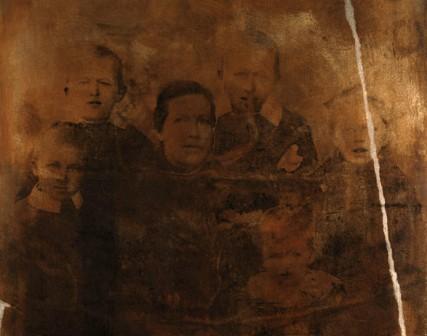
Maureen de Jager, senior lecturer in Fine Art, has been selected as one of only seven finalists in the Nelson Mandela Metropolitan Art Museum’s (NMMAM) Biennial Exhibition and Award for 2010 - a prestigious regional fine art competition open to all artists resident in the Eastern Cape.
The NMMAM Biennial Award is unique in that the prize is an opportunity for the winning artist to create an exhibition of new work, funded through a generous sponsorship and hosted by the Museum. The winner will be decided in March 2011.
The work that got De Jager selected is called 'Winburg 1901'. It consists of a diptych, each panel measuring 1m x 61cm. It was made using photocopy transfer, rust and gun blue paste on sheets of mild steel.
De Jager explains, “The source material for the first panel is an old family photograph of my great-grandmother Maria de Jager surrounded by her five children.
“For the second panel I replicated the inscription on the back of the photograph, which reads: 'Konsentrasie Kamp Winburg 1901'. It is evident, from the inscription, that the photograph was taken in the Winburg Concentration Camp where Maria and her children were held captive during the Anglo-Boer war.
“In the space of a few months Maria lost three of the five children in the photograph due to illness and malnourishment, as well as a baby who was born in the camp and lived for a mere ten days (Maria was seven months pregnant at the time of her capture).”
De Jager is interested in the photograph itself as a residue of history, and of the ghostly presence of people long gone. She says, “When I discovered this photograph I was initially surprised that there were concentration camp photographers, but on second thoughts it makes sense: in a place of imminent death, the desire to preserve some trace of the living is surely heightened.
“It is both poignant and unnerving that this small, distressed memento is darkening and fading with age, undergoing the sort of erasure that one normally associates with diminishing memory.”
Visually, the patina of gun blue – which is generally used to restore the steel components of old guns – evokes the sepia tones of an old photograph. But it also links to the artwork conceptually. Like the work itself, both memory and photography are attempts to restore the past and to halt the passage of time, if only temporarily. De Jager adds, “It is also significant that gun blue paste has been used in an artwork depicting those who suffered in a historic South African war.”
The initial selection down to the seven finalists was on the basis of individual works submitted for the competition, but the overall winner will be decided in March on the basis of his/her proposal for a forthcoming solo show.
De Jager says, “Each of the finalists now has a compelling incentive to conceptualise and plan an exhibition of new work - and I'm sure that this process will be beneficial to every finalist regardless of the outcome.
“I have been planning a new exhibition for some time now, so I am seeing this as an opportunity to refine my thoughts and to write a proper proposal.”
